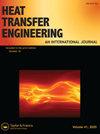涡发生器放置和纳米流体对通道流动换热的影响
IF 1.6
4区 工程技术
Q3 ENGINEERING, MECHANICAL
引用次数: 0
摘要
摘要本文尝试采用经典的三角小翼布置方式来提高板翅式换热器的换热性能,并与已有文献进行了比较。计算区域是通过将三角小翼从其原始位置错位来发展的,因此没有额外的流动几何压力损失。利用ANSYS Fluent计算三维Reynolds平均Navier-Stokes方程,对各流域进行了分析。考虑两种不同的工作流体,一种是水和纳米流体(含氧化铝的水)。分析了水和纳米流体中不同位置小翼的换热特性。通过对数值结果的分析,对板翅式换热器的性能进行了优化,优化了小翼和纳米流体的位置。当纳米流体含量为0%,雷诺数为300时,case 3的Nusselt数增加了23.2%,压降降低了17.7%。它代表了传热的增强。声明作者声明在本研究工作中无利益冲突。本文作者sobula Reddy Kummitha是印度纳尔萨普尔B V Raju理工学院机械工程系的副教授。他分别于2020年和2013年获得NIT Silchar热工专业博士和硕士学位。在过去的7年中,他一直致力于超音速燃烧,节能建筑,传热和计算流体动力学。Siva Krishna Reddy Dwarshala是印度金奈SRM科学技术研究所机械工程系的助理教授。他于2012年获得孟买印度理工学院博士学位。从2011年到2017年,他作为计算流体动力学工程师拥有6年的行业经验。在过去的7年里,他一直致力于超音速燃烧,节能建筑和传热。Karthik CharyKarthik Chary在印度Narsapur的B V Raju理工学院机械工程系攻读技术学士学位。主要研究方向为传热、流体力学和计算流体动力学。Venu Mangam是印度安得拉邦比希玛瓦拉姆维什努普尔维什努理工学院机械工程系教授兼高级研究员。他有18年的教学经验,并在同行评议的期刊上发表了许多文章。他于2011年在印度理工学院获得博士学位。Harikrishna Chirala是比希玛瓦拉姆毗湿奴女子工程学院(A)机械工程系的副教授兼主任。他在金属成形工艺领域完成了博士学位。他的研究领域包括增材制造、焊接和金属基复合材料。他在瓦朗格尔国立理工学院获得了硕士学位。纳迦·马勒斯瓦拉奥·巴蒂纳是印度安得拉邦比希玛瓦拉姆市毗湿奴女子工程学院机械工程系的助理教授。在过去的4年里,他一直在金属成形领域工作。本文章由计算机程序翻译,如有差异,请以英文原文为准。
Effect of Vortex Generator Placement and Nanofluids on Channel Flow Heat Transfer
AbstractIn this research, an attempt has been made to enhance the heat transfer for a plate-fin heat exchanger with the new arrangement of classic delta winglets used for vortex generators and compared the same with the existing literature. The computational domains are developed by dislocating delta winglets from their original position, so there is no additional pressure loss with flow geometry. All the flow domains are analyzed by computing the 3D Reynolds averaged Navier–Stokes equations using ANSYS Fluent. Two different working fluids are considered one is water and nanofluids (water with Aluminum oxide). Heat transfer characteristics are analyzed for different placements of winglets for both water and nanofluids. The plate-fin heat exchanger’s performance has been optimized with the optimum location of winglets and nanofluids from the analysis of numerical results. For the case of 0% nanofluids at 300 Reynolds number, Case 3 Nusselt number has been increased by 23.2% with a decrease in pressure drop of 17.7% with the dislocation of one winglet. It represents the enhancement of heat transfer. Disclosure statementThe authors declare no conflict of interest in this research work.Additional informationNotes on contributorsObula Reddy KummithaObula Reddy Kummitha is an Associate Professor at the Department of Mechanical Engineering, B V Raju Institute of Technology, Narsapur, India. He obtained his Doctorate and Master of Technology in Thermal Engineering from NIT Silchar in 2020 and 2013, respectively. For the past 7 years, he has been working on supersonic combustion, energy efficient buildings, heat transfer, and computational fluid dynamics.Siva Krishna Reddy DwarshalaSiva Krishna Reddy Dwarshala is an Assistant Professor at the Department of Mechanical Engineering, SRM Institute of Science and Technology, Chennai, India. He obtained his Doctorate from the Indian Institute of Technology, Bombay, in 2012. He has 6 years of industrial experience as a computational fluid dynamics engineer from 2011 to 2017. For the past 7 years, he has been working on supersonic combustion, energy efficient buildings, and heat transfer.Karthik CharyKarthik Chary is pursuing a Bachelor of Technology in the Department of Mechanical Engineering, B V Raju Institute of Technology, Narsapur, India. His research interests are heat transfer, fluid Mechanics and computational fluid dynamics.Venu MangamVenu Mangam is Professor and HOD at the Department of Mechanical Engineering, Vishnu Institute of Technology, Vishnupur, Bhimavaram, Andhra Pradesh, India. He has 18 years of teaching experience and has published many articles in peer-reviewed journals. He obtained his Doctorate from the Indian Institute of Technology, Kharagpur, in 2011.Harikrishna ChiralaHarikrishna Chirala is an Associate Professor and HOD of the Mechanical Engineering Department, Shri Vishnu Engineering College for Women(A), Bhimavaram. He has completed his Ph.D. in the area of metal forming processes. His research areas include additive manufacturing, welding, and metal matrix composites. He did his M.Tech from NIT warangal.Naga Malleswararao BattinaNaga Malleswararao Battina is an Assistant Professor at the Department of Mechanical Engineering, Shri Vishnu Engineering College for Women, Bhimavaram, Andhra Pradesh, India. He has been working in the field of metal forming for the past 4 years.
求助全文
通过发布文献求助,成功后即可免费获取论文全文。
去求助
来源期刊

Heat Transfer Engineering
工程技术-工程:机械
CiteScore
4.50
自引率
17.40%
发文量
111
审稿时长
7.5 months
期刊介绍:
Publishing 18 issues per year, Heat Transfer Engineering is an unparalleled resource for key advances in the field of heat transfer for the practicing engineer and other workers in the field. The journal publishes analytical, numerical, and experimental articles of lasting interest in the general area of heat-mass transfer and the related fluid mechanics and thermodynamics.
In a clear, easy-to-read format, the journal includes refereed papers of original work, state-of-the-art reviews, articles on new developments in equipment or practices, reviews of fundamentals, heat in history articles, book reviews, news items on people and companies in the field, advertising, and any other items that may be appropriate.
All submitted manuscripts are subject to initial appraisal by the Editor and/or selected members of the Editorial Board, and, if found suitable for further consideration, to peer review by independent, anonymous expert referees.
 求助内容:
求助内容: 应助结果提醒方式:
应助结果提醒方式:


